11 Bullet Journal Layouts For Beginners
Talking about Bullet Journaling for beginners, an important question is what pages to use when you’re getting started.
There are tons of page ideas that you can use. As a Bullet Journaling enthusiast myself, I’ve come across countless themes and layouts that will suit any skill level and any lifestyle.
Rest assured that you don’t need to be a creative wizard to start, and you don’t need to feel overwhelmed. To give you a head start, I’ve compiled some of my top recommendations for Bullet Journal layouts for beginners. So buckle up, grab a pen, and let’s get started!
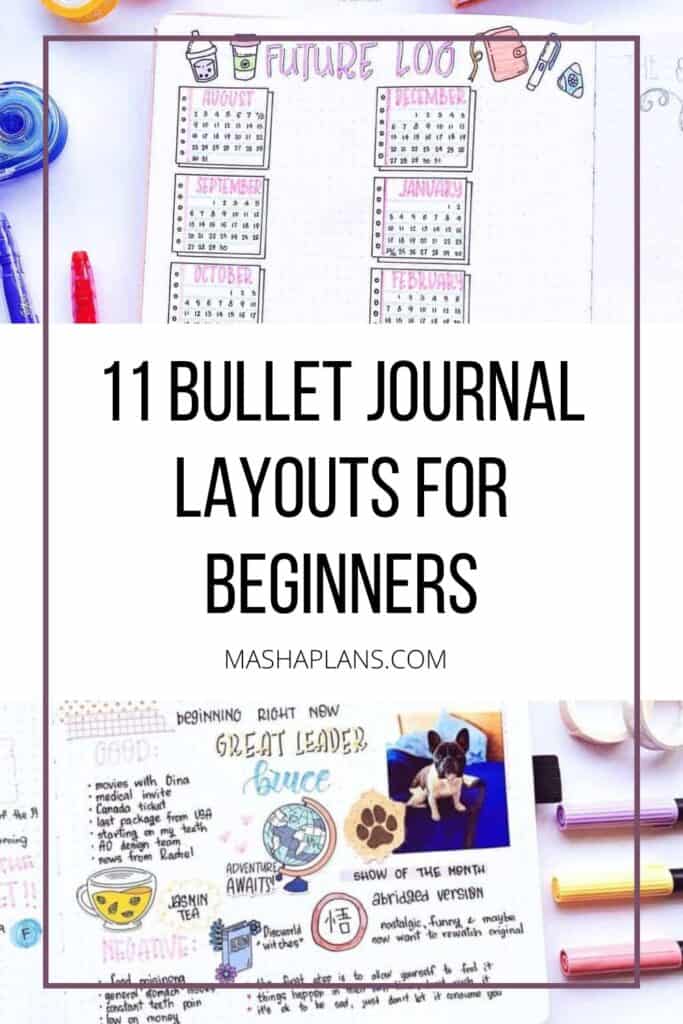
It can be difficult to know where to begin, but with a little bit of guidance, a Bullet Journal can become a unique tool for goal setting, productivity tracking, and creative organization.
With the right layouts and enough practice, you’ll find yourself confidently designing pages that reflect your personal style and will help keep tasks on track.
But before we look into the best pages for beginners, here are a few tips on how to choose the right pages that will work for you.
Tips For Choosing Bullet Journal Pages
Once you decide to start a Bullet Journal, I bet you get excited about all the pages and possibilities, and you probably have a list of 50 ideas you want to try right away.
This, however, is not a good idea because it can easily turn this powerful productivity tool into just another chore you have to do every day.
So here are a few of my best tips for you to follow so you end up with a perfect custom journal for your own needs.
- Start With the Basics
Before we dive into the deep end, let’s start with the basic pages. Don’t go overboard with ALL the pages out there; follow the basic structure first. Don’t worry; below, there are all the basic pages you need as well.
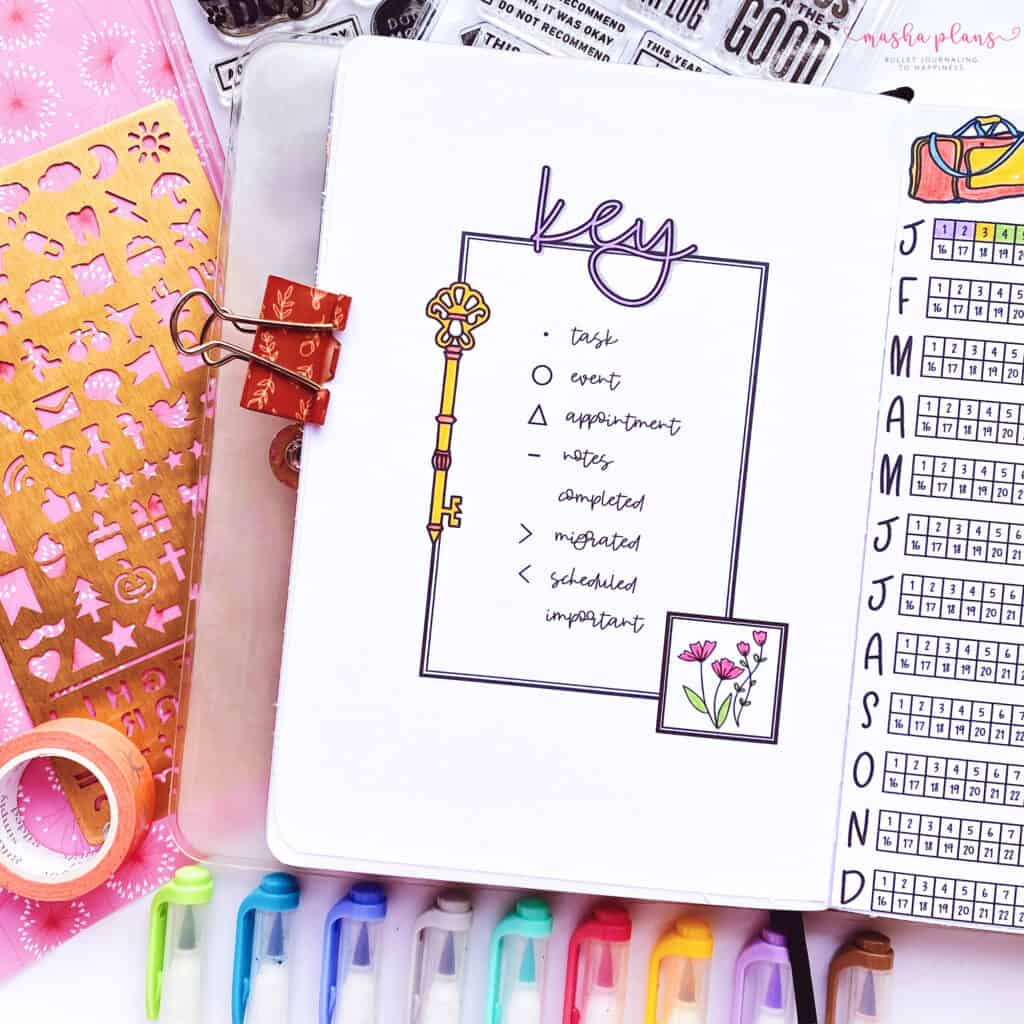
- Consider Your Needs
Now, this is where it gets personal. Think about why you’re starting a Bullet Journal. Are you looking to manage your time better? Maybe a daily log or a time tracker would be useful. Want to improve your health? Consider a meal planner or fitness tracker. Dreaming of reading more books? How about a bookshelf page where you can list the books you want to read and color them in as you finish them? Remember, your Bullet Journal is your personal tool; it should fit your needs like a glove.
- Keep It Simple
I know, I know. You’ve probably seen those elaborate Bullet Journal spreads on Instagram and Pinterest and thought, “I could never do that.” Well, guess what? You don’t have to! Your Bullet Journal is for you, and if simple and functional is your style, go for it! Don’t feel pressured to create a work of art if all you want is a straightforward planner.
- Experiment and Evolve
One of the best things about Bullet Journaling is that it’s flexible. Don’t be afraid to try new pages or layouts. If they don’t work for you, you can simply leave them out of your next journal. Your Bullet Journal will evolve with you, becoming a reflection of your journey.
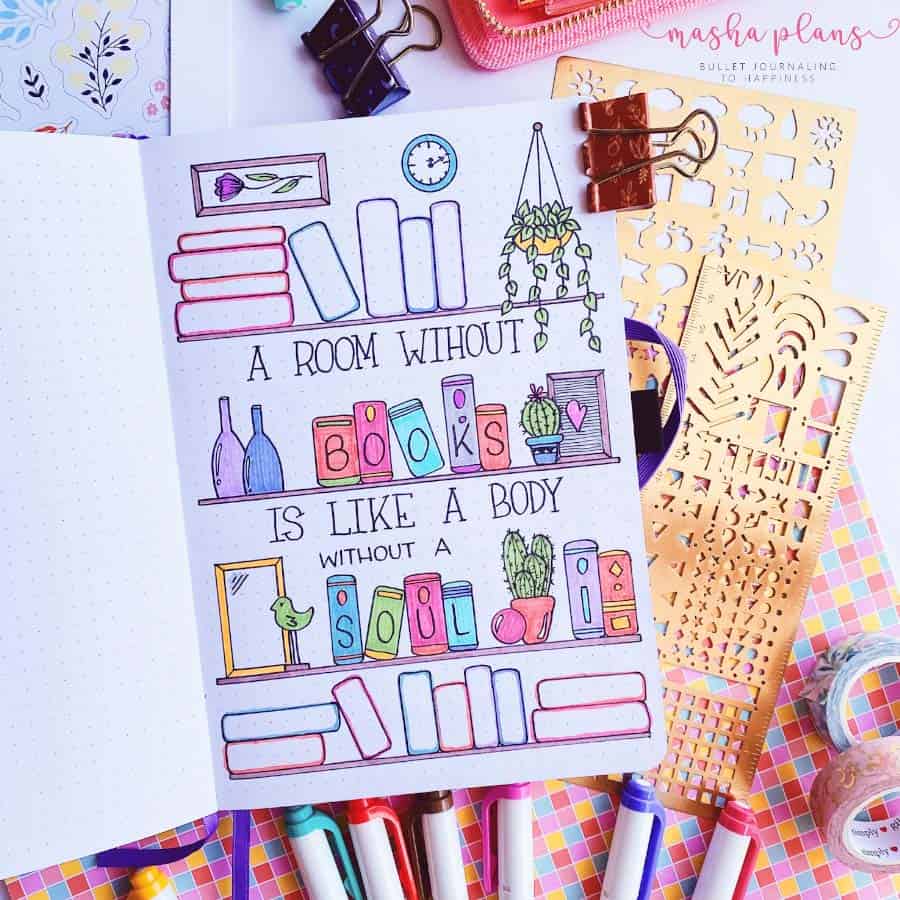
- Have Fun!
Last but not least, have fun! This is your space to explore, dream, and create. Whether you’re doodling in the margins or color-coding your entries, make sure you’re enjoying the process. After all, Bullet Journaling isn’t just about staying organized; it’s about improving your life and having fun along the way.
I hope these tips help you decide what pages to include in your Bullet Journal. Remember, there’s no right or wrong way to Bullet Journal.
This post may contain affiliate links. They will be of no extra expense for you, but I receive a small credit. Please see my Disclosure for more details. Thank you for supporting Masha Plans!
Bullet Journal Supplies
As a beginner to the world of Bullet Journaling, it’s easy to get lost in the overwhelming array of supplies available on the market. You may be tempted to purchase everything in sight, only to realize later on that you hardly use any of it.
Instead, focus on a few key supplies that are worth investing in. Here are my recommendations:
- A journal. You don’t need to start from an overly expensive journal, but whether your pens bleed or ghost will largely depend on the quality of the paper. I recommend going for a journal with at least 120 GSM. A Lemome journal is a good one to start with.
- Fineliners. These black pens are the blood of all Bulelt Journal pages; the beautiful black archival ink will help your pages look amazing. I recommend getting Sakura Pigma Micron pens, which also come in different nib sizes, so you can add more variety to your pages and doodles.
- Markers. In case you need something more colorful, you’ll want to get some markers, like Crayola Super Tips. They come in many colors and are pretty affordable. Plus, you can actually use them to create brush lettering as well.
- Stencils. If you’re looking for a tool to help you set up pages faster and decorate them as well, there is no better way than to do it with stencils. I recommend trying these stencils from Amazon.
Now you have all your supplies and the mindset ready, it’s time to get planning.
Before we dive in, I want you to be clear that even though some of these are considered staples of the Bullet Journal system, you’re creating your own personal journal, and you don’t have to follow any rules.
You don’t have to use all these pages! Always remember that your journal has your rules, and it’s up to you to try different pages and figure out what works best for you and your needs.
And make sure you scroll until the end to get a FREE course on Bullet Journaling for beginners.
Bullet Journal Layouts For Beginners
There are so many different Bullet Journal layouts it’s easy to get lost and overwhelmed, but I’ve got you covered.
I’ve been customizing and tweaking my Bullet Journal for years, and now looking back, these are some of the best layouts I always recommend beginners to get started with.
Bullet Journal Key
Starting with one of the basic pages – a Bullet Journal key. This is basically a way for you to decode the language of your journal.
The Bullet Journal method has its own code on how you add information to your pages, which helps you to make it faster and more visual, therefore, easier to understand.
The key is the page that will help you as a beginner to learn this code and will be there to remind you which symbols to use.
It’s not as complicated as it sounds, it’s just to make sure you use certain symbols for certain types of entries.
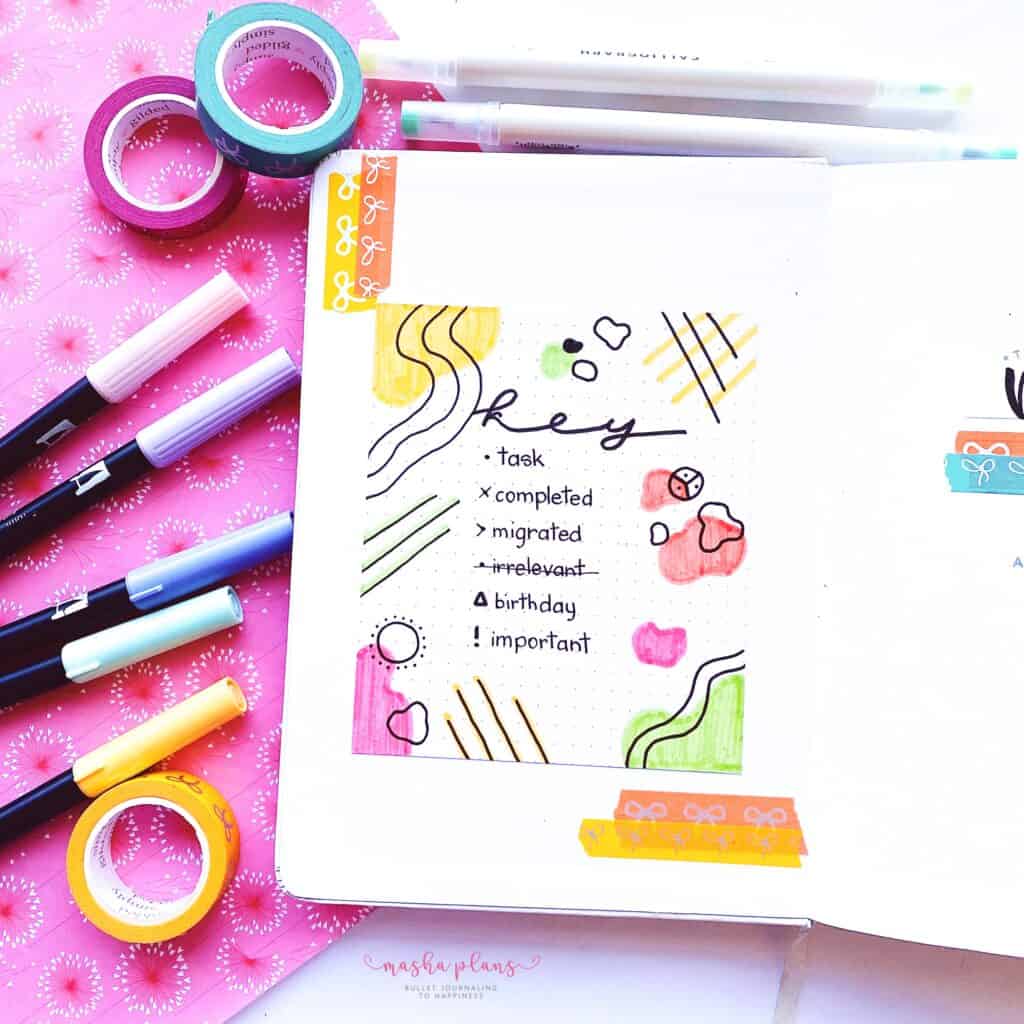
Cover Page
You don’t necessarily need one, but I always find that it’s very fun to have one. It helps to create a kind of mood for your journal and get your creative juices started.
I like adding some useful information to the cover page, like maybe the year or dates when I’m using the journal. That’s definitely helpful with future archiving.
Apart from that, I find that it’s also super fun to maybe choose the word of the year for your journal. It kind of helps you to set up a purpose for your journal and stay concentrated on what you actually want to get from it.
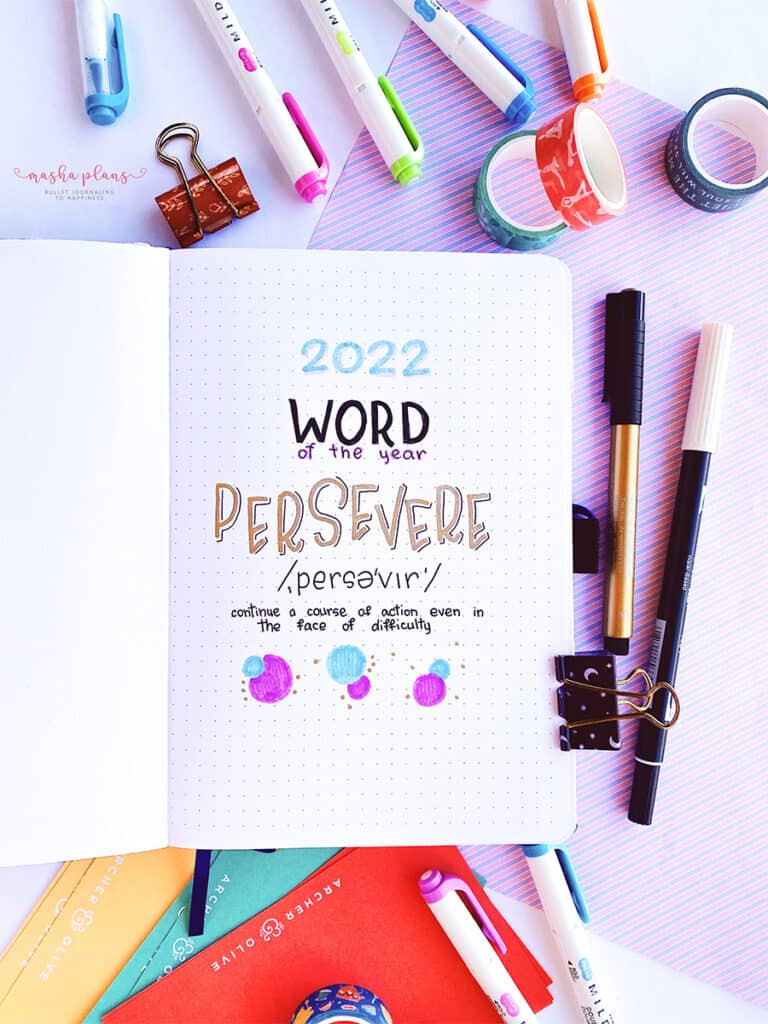
Future Log
This is definitely a spread I recommend you try, and it’s considered one of the must-have Bullet Journal pages for a reason.
It’s basically where you plan the upcoming year and write down all the necessary dates like birthdays, doctor appointments, anniversaries, vacations, and so on. Basically, everything you need to plan beyond your current month goes here.
I also really like this spread because of the overview of the upcoming year that it provides.
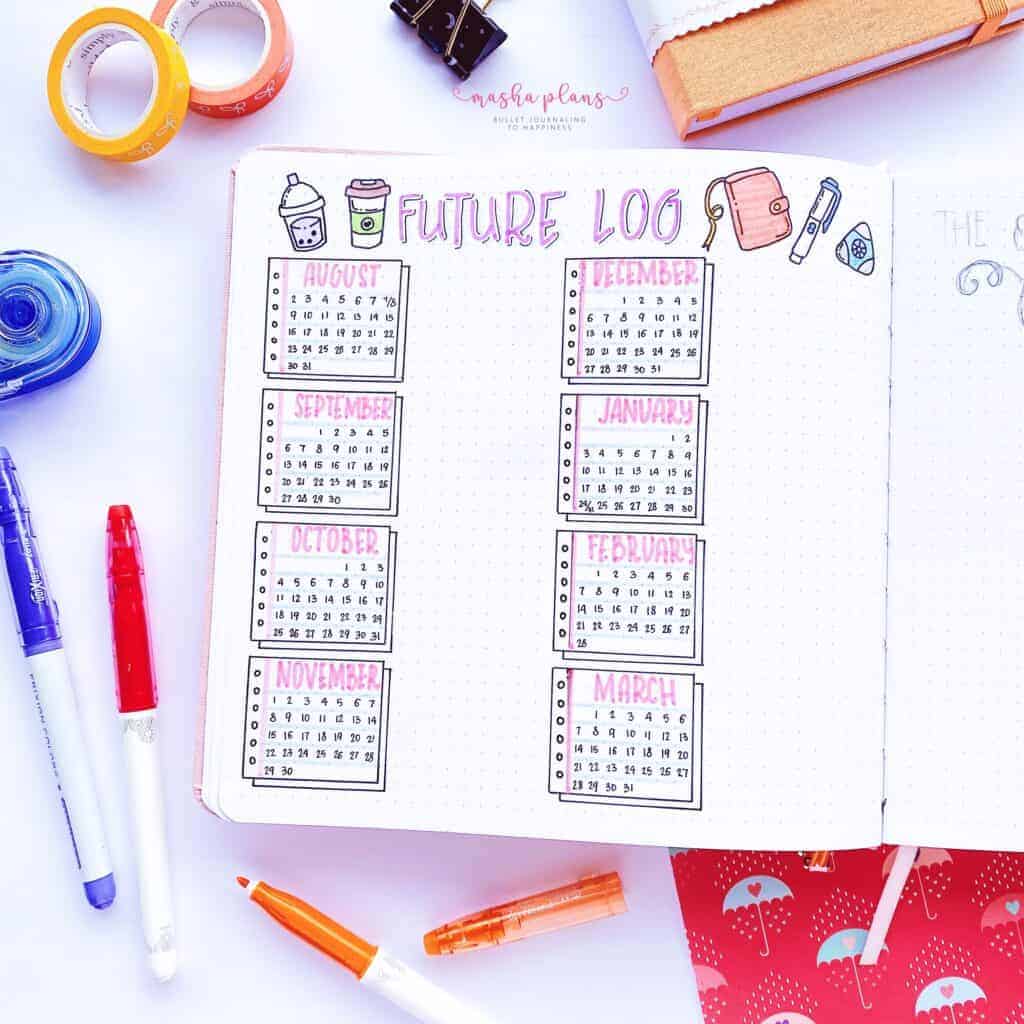
Yearly Goals
This is definitely a beneficial spread to have in every journal, I think. It will help you to stay productive and on track with your life.
I find that it helps you to figure out where you’re going and set a bit of a plan or at least an orientation for this journal and the upcoming year.
The only important thing is to make sure you’re not too strict about your goals since life changes and your goals might change as well, so it’s important to keep them fluid.
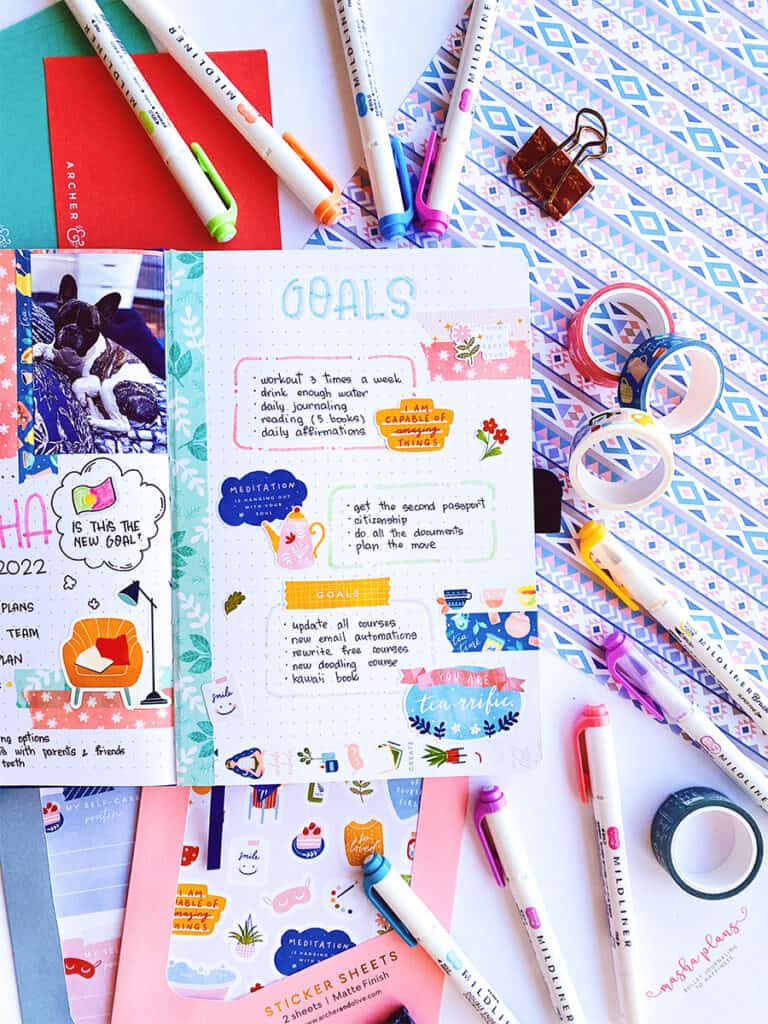
Bullet Journal “Why”
It’s not a common page you usually see people create, but I always found it to be very useful.
Starting a Bullet Journal is a new habit you have to work on, and usually, as the novelty factor wears off, the enthusiasm does as well, and many people drop journaling altogether.
A great solution to it is to make sure that you know exactly why you’re starting your journal so you can use your “why” as motivation to work through slumps.
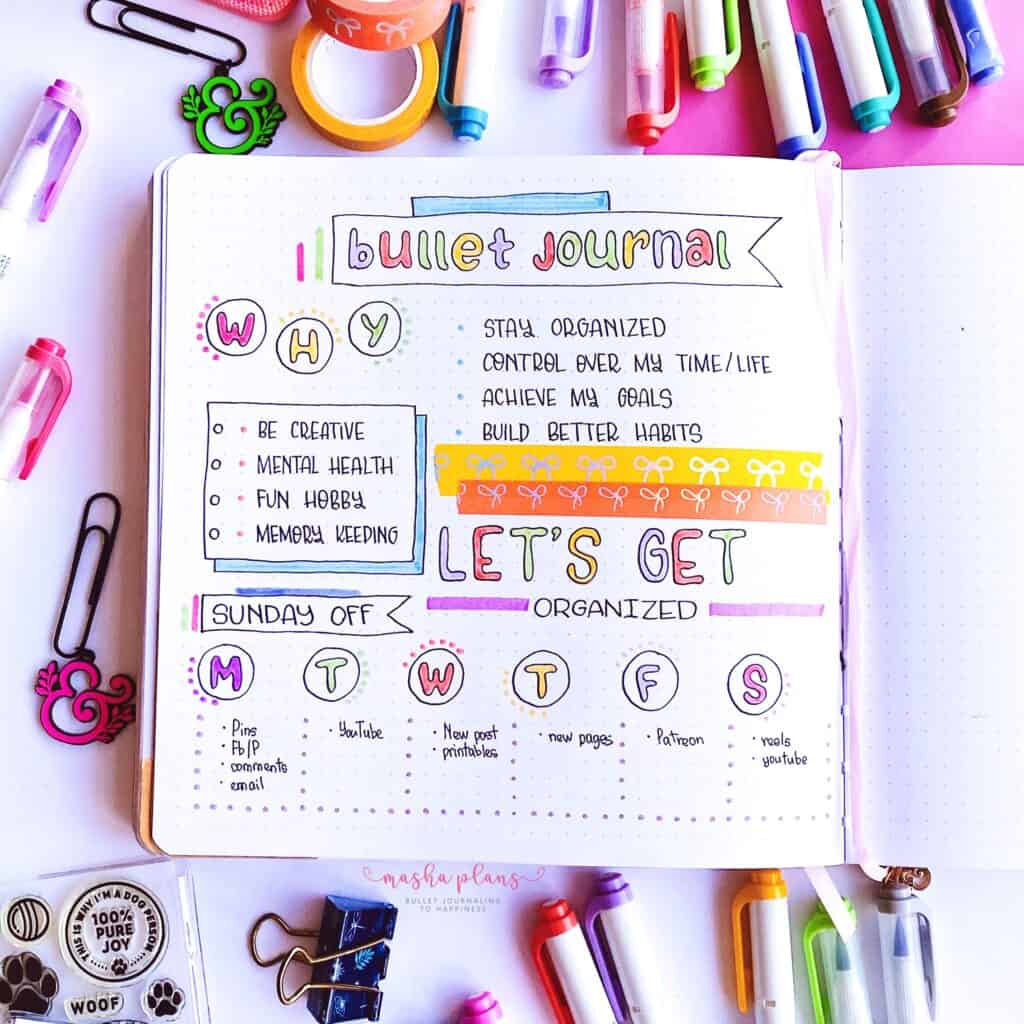
About Me Page
I love this page for many reasons, but for beginners, I recommend it because it can be kind of a reflection of who you are when you’re starting that specific Bullet Journal.
And that way, after it’s all out of pages, you can look back and see how many pages changed ad how far you’ve gone in just one year.
It’s also just a fun page to create and to remind yourself of what’s happening in your life and where you want to go from there.
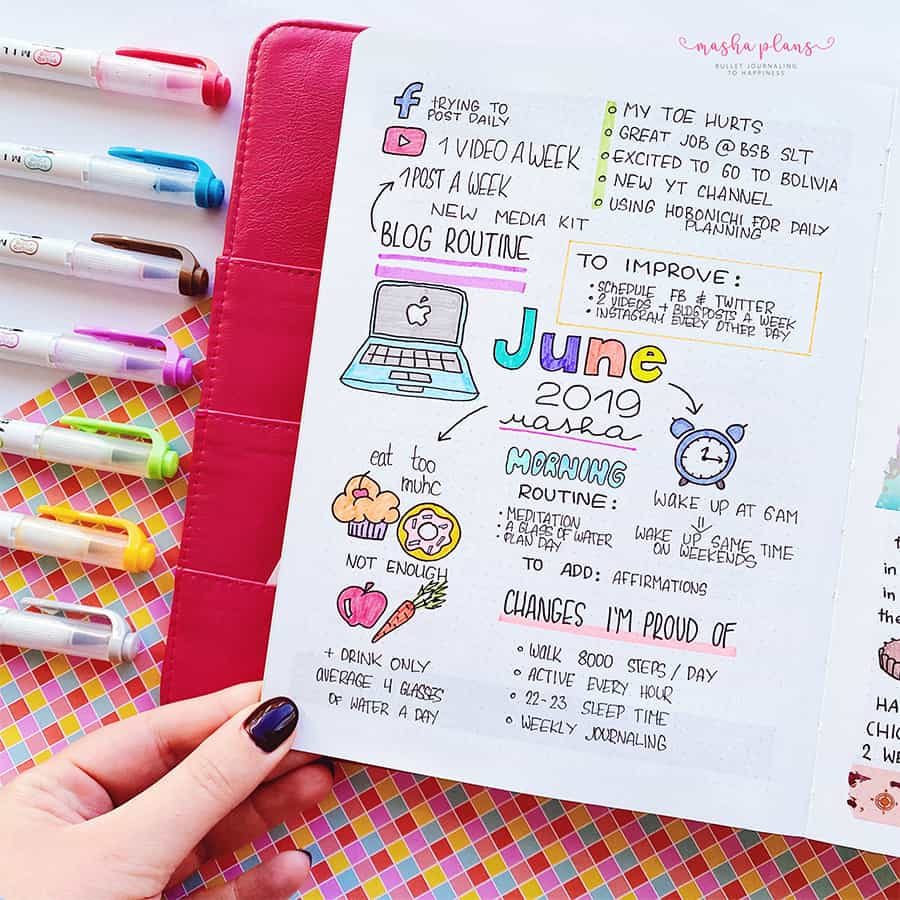
Monthly Log
One more of the basic pages for your Bullet Journal, and easily enough, this is where you’re supposed to plan your month.
I usually go for a monthly calendar since for me this is the most intuitive way to o. But you definitely can go as simple with this page as you want. Or vice versa, use two pages to make sure you can fit all your appointments and planning.
A monthly log is also something that often comes with a monthly to-do list. I find it very useful to offload all the tasks at the beginning of the month and work on them from that.
I recommend you try different formats and see what works for you and what you like creating the most.
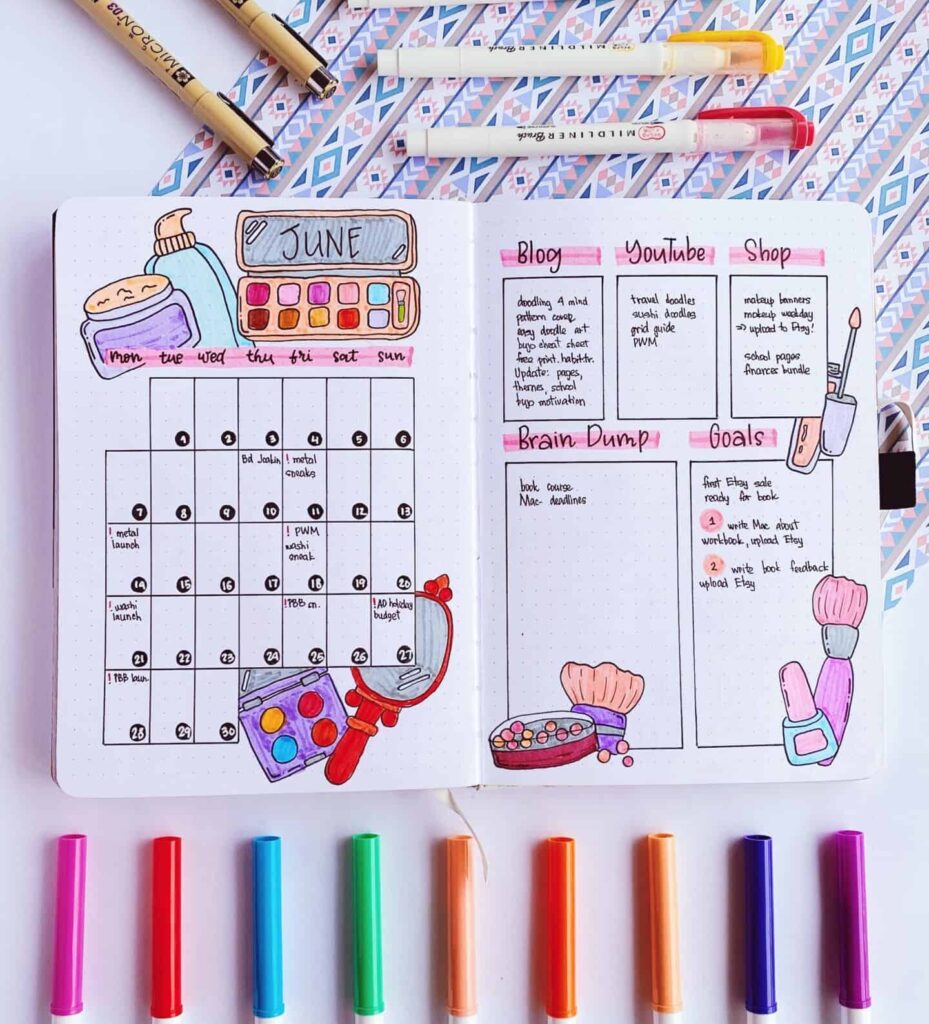
Habit Tracker
This spread is quite self-explanatory; it’s a page to help you track any new habits you want to establish or any habits you want to get rid of.
You can have monthly, weekly, or even yearly habit trackers; just be sure you’re not overdoing and not trying to track too many things at once.
The way it works is that you create a tracker, and each day you make a new habit or do not do the habit you try to stop, you mark it in the tracker as a success!
This definitely helps to keep you motivated and proud of your work on new habits.
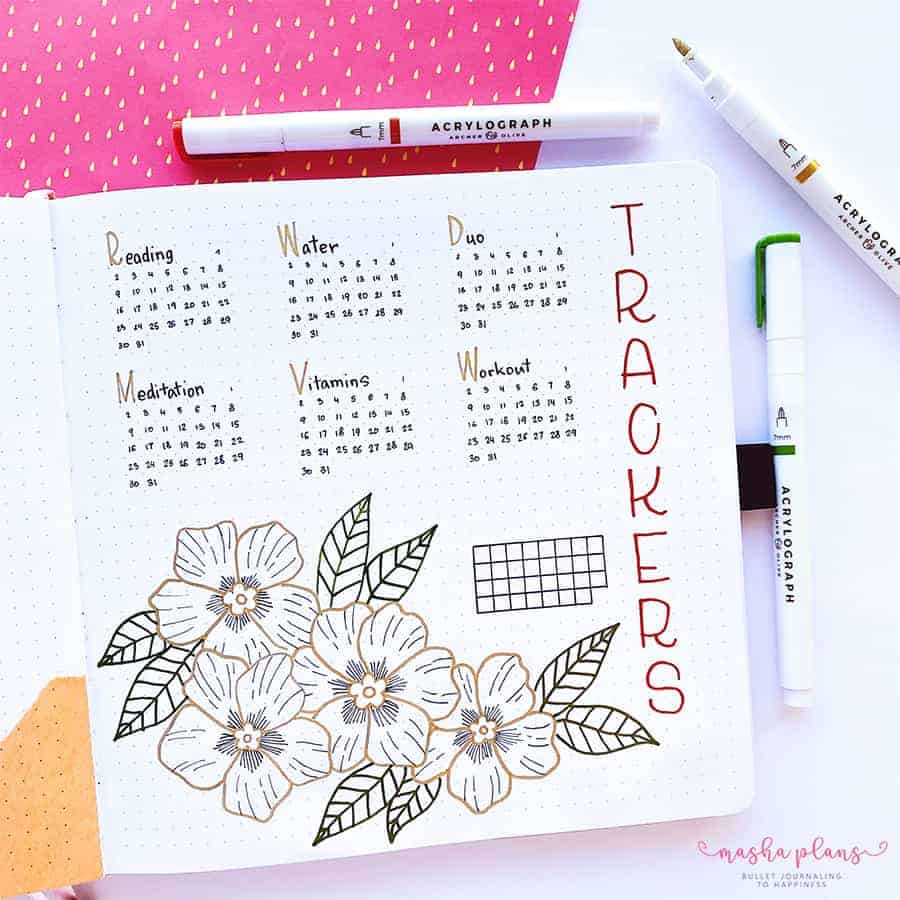
Mood Tracker
Another tracker that is very commonly used among the Bullet Journal community, and for a good reason.
It’s a great way to show some self-love and take care of your mental health.
Basically, it’s a page to track your moods. You assign colors to your moods (or create a gradient from the best to the worst mood) and olor each day to note how your mood was.
It can help you with so many things!
I found it very useful, especially when I’m going through some difficult times. It helps to see how my mood fluctuates and figure out what other factors influence it so I can avoid the darker days.

Weekly Spread
Another must-have element of the Bullet Journal method, these pages are there to help you with your day-to-day planning.
There are many different ways to set it up, but the basic idea is that on two pages, you have enough space for writing tasks for seven days of the week and use the rest of it however you see fit.
It could be a to-do list or maybe a weekly habit tracker. Whatever you need! Weekly spreads are kind of like Lego castles; you can play around with which blocks you’ll be using on your page.
The important thing is for you to have space for your day-to-day planning and keep on track with all the tasks and responsibilities.

If you need more space, you can always plan day by day, so you don’t actually set up a weekly spread but write down all you need for the day and then start on the second day right below where you stopped.
Monthly Review
This spread can be beneficial in many ways.
On one side, it can help you kind of review your month, see how many amazing things actually happen, and generally have a better feeling about how your life is going.
If you add some positive elements to your monthly log, it can also help you build a more positive outlook on your life.
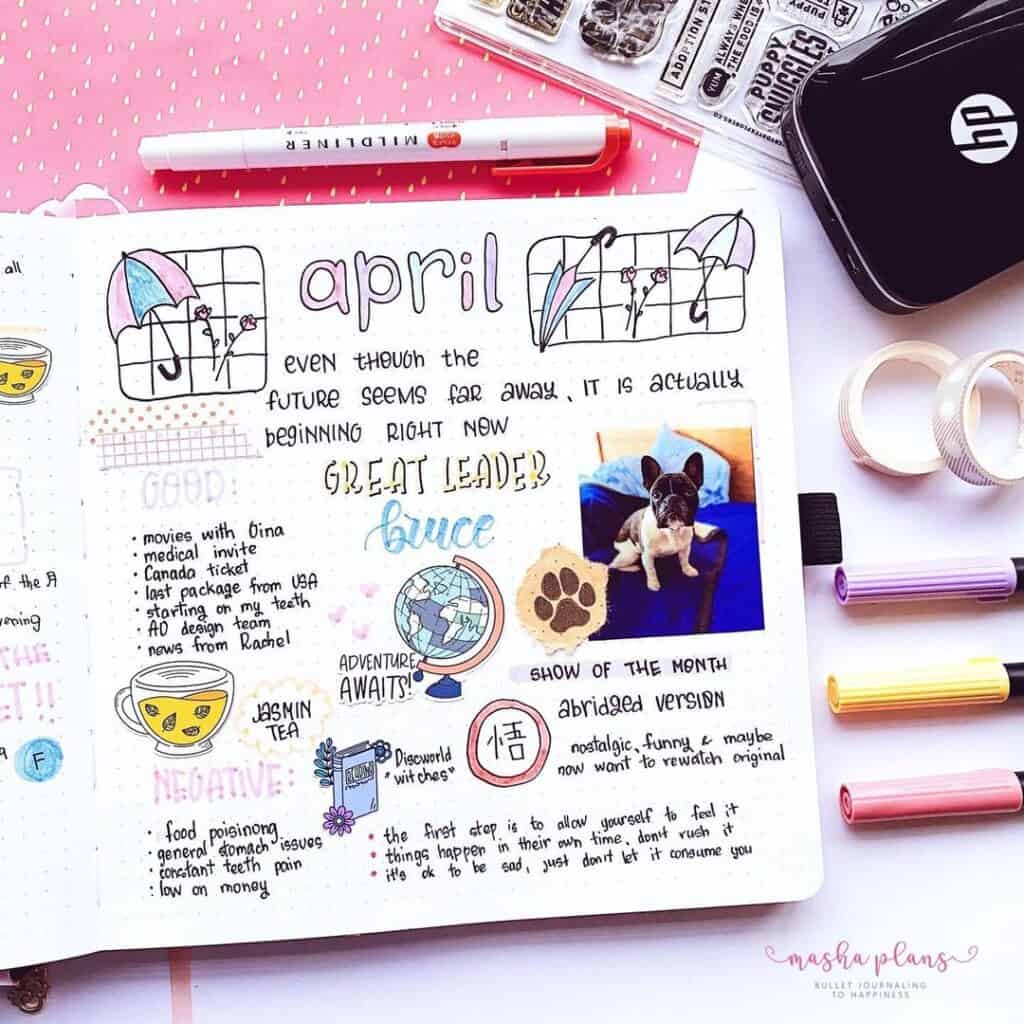
But for Bullet Journal beginners, it can also be very beneficial if you use your monthly review to concentrate more on how you used your Bullet Journal, what pages worked and which ones didn’t, and what you can do better next month to get the most out of your BuJo.
Before you figure out the format that works best for you, you should experiment with new pages and new ways to set them up. This spread will help you keep track of what you’ve tried and what works, and what doesn’t.
Free Bullet Journaling Course For Beginners
As a beginner, you might have a lot of questions and uncertainties. That’s why I’ve created a free course for beginners. It will walk you through every step of setting up a complete and functional Bullet Journal.
Simply sign up in the form below, and you’ll get all the deeds on how to get started.
More Resources
There are many more resources for beginners here, so I thought I’d share a few more posts that I’m sure you’ll find useful.
Read these next:
- About Me Page In Your Bullet Journal And Why You Need One
- Why You Need A Monthly Review Page In Your Bullet Journal
- 7 Essential Bullet Journaling Tips For Beginners
Hope this post was interesting. If you find it so, please share! If you enjoy my content and want to show your appreciation, please consider supporting me with a cup of coffee.
And remember: Keep Bullet Journaling, and Don’t Be A Blob!

















